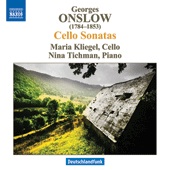 Following last night’s excellent live performance of two piano trios by George Onslow (1784-1853) by the Fibonacci trio, it’s time to share news of a great German recording of three sonatas for cello and piano recently released by Naxos.
Following last night’s excellent live performance of two piano trios by George Onslow (1784-1853) by the Fibonacci trio, it’s time to share news of a great German recording of three sonatas for cello and piano recently released by Naxos.
- Classical Music 101: What Does A Conductor Do? - June 17, 2019
- Classical Music 101 | What Does Period Instrument Mean? - May 6, 2019
- CLASSICAL MUSIC 101 | What Does It Mean To Be In Tune? - April 23, 2019
German cellist Maria Kliegel and pianist Nina Tichman recorded these three companion works — all were published as Op. 16 in 1821 — with a combination of strength and grace that seems to be what is necessary to give this essentially poised, Classically-shaped, aristocratic music interest.
We don’t get the moments of high drama of Beethoven, or the brooding quality that keeps coming out in Franz Schubert’s darker moments. This is not adventurous music, but it is beautiful and written with a high degree of craft.
The second sonata, which starts in the dramatic key of C minor is a very substantial piece, with four movements running more than a half hour, and the opening Allegro espressivo has a clear sense of early-Romantic sweep.
Onslow likes to have fun with his Menuetto movements — and the second sonata is the only work in this set to get one.
If you like the chamber music of Franz Schubert, you’ll find a lot to enjoy. You can find more details here.
+++

In his booklet notes for this album, Keith Anderson answers the question that was on the minds of several people at intermission last night: What was the scandal that drove the Onslow family out of England?
According to Anderson, George’s father Edward, son of the first Earl of Onslow, was caught propositioning a fellow male guest at a Royal Academy Exhibition in May, 1781. Edward, who had political ambitions until then, resigned his seat in Parliament and escaped across the channel to France.
Edward found the welcoming arms of an heiress, Marie-Rosalie de Bourdeilles de Brantôme, bought himself a château near the south-central city of Clermont-Ferrand, had George, the first of several children, and lived out the rest of his life (to 1829) as a country gentleman.
Two of George Onslow’s brothers apparently became painters, which shows a strong arts-tolerant streak in the household. You can find all the programme notes at the Naxos site link above.
John Terauds
- Classical Music 101: What Does A Conductor Do? - June 17, 2019
- Classical Music 101 | What Does Period Instrument Mean? - May 6, 2019
- CLASSICAL MUSIC 101 | What Does It Mean To Be In Tune? - April 23, 2019



